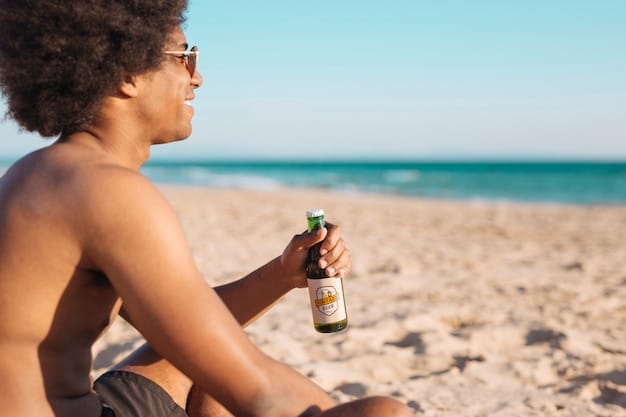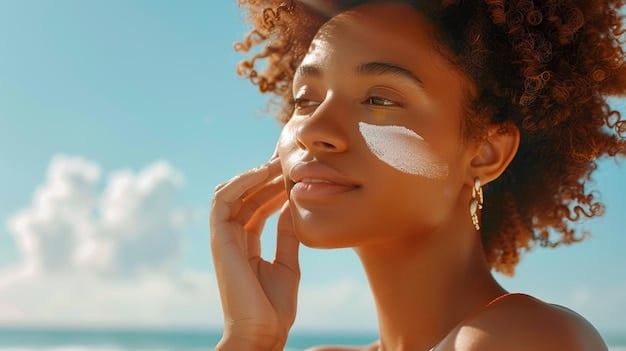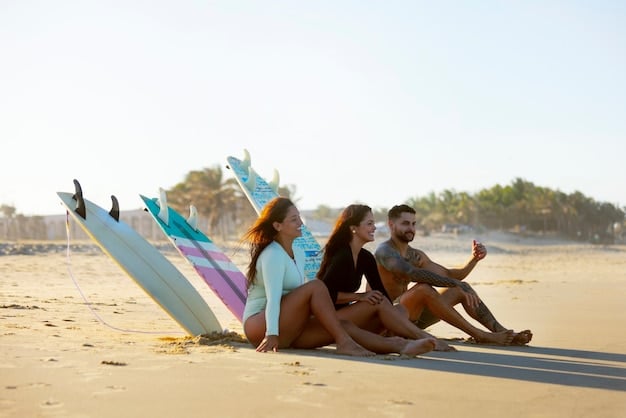Optimal SPF for Surfing in 2025: Skin Protection Tips

The optimal SPF level for surfing in 2025 depends on factors like skin type, UV index, and duration of exposure, but a broad-spectrum, water-resistant SPF 30 or higher is generally recommended, coupled with reapplying every two hours and using additional protective measures.
Surfing is an amazing sport, but protecting your skin from the sun is crucial. Finding the optimal SPF level for surfing in 2025 is essential for long-term skin health. Let’s dive into expert tips to shield your skin while you catch those waves.
Understanding Sun Protection for Surfers
Surfing exposes you to intense sunlight, making sun protection extremely important. Understanding the basics of SPF and how it works is the first step in keeping your skin safe.
What is SPF and How Does It Work?
SPF, or Sun Protection Factor, measures how well a sunscreen protects you from UVB rays, which are the primary cause of sunburn. A higher SPF number means more protection.
However, SPF values are not linear. For instance, SPF 30 blocks about 97% of UVB rays, while SPF 50 blocks about 98%. No sunscreen can block 100% of UVB rays.
UVA vs. UVB Rays: Why Broad Spectrum Matters
While SPF mainly addresses UVB rays, UVA rays also pose significant risks, including premature aging and skin cancer. That’s why broad-spectrum sunscreens are crucial.
Broad-spectrum sunscreens protect your skin from both UVA and UVB rays. Make sure your sunscreen is labeled “broad spectrum” to ensure complete protection.

Consider these key points:
- Choose a broad-spectrum sunscreen.
- Understand that higher SPF numbers offer marginally better protection.
- Apply sunscreen generously and reapply frequently, especially after surfing.
Understanding sun protection is critical for surfers to maintain healthy skin while enjoying their sport. By choosing the right sunscreen and applying it correctly, you can minimize the risk of sun damage.
Factors Influencing Optimal SPF Level
The optimal SPF level isn’t one-size-fits-all. Several factors, including your skin type, the UV index, and the duration of your surfing session, play a significant role in determining the level of protection you need.
Skin Type and Sensitivity
People with lighter skin are more sensitive to the sun and require higher SPF levels. Those with darker skin have more natural protection but still need sunscreen.
Knowing your skin type can guide you in selecting the appropriate SPF. Consider consulting a dermatologist to determine your skin’s sensitivity.
UV Index and Time of Day
The UV index measures the strength of the sun’s UV radiation. The higher the UV index, the greater the need for sun protection. UV radiation is strongest between 10 a.m. and 4 p.m.
Check the UV index forecast before you go surfing. During peak hours, opt for a higher SPF level and seek shade when possible.
Duration of Surfing Session
The longer you’re exposed to the sun, the more protection you need. Sunscreen wears off over time, especially in water. Reapplication is vital.
For extended surfing sessions, use a water-resistant sunscreen with a high SPF and reapply every two hours, or more frequently if needed.
Keep these tips in mind:
- Assess your skin type and its sensitivity to the sun.
- Monitor the UV index and adjust your SPF accordingly.
- Reapply sunscreen regularly, especially during long surfing sessions.
Considering these factors will help you determine the optimal SPF level for your specific needs, ensuring you’re adequately protected while surfing.
Recommended SPF Levels for Surfing in 2025
Based on current research and trends, a few recommendations for **SPF levels** could be made when surfing in 2025. You’ll want to balance robust protection with practical application.
Minimum SPF 30: A Good Starting Point
SPF 30 is often considered the minimum to be effective. This level blocks approximately 97% of UVB rays. It is an excellent starting point for most surfers.
However, keep in mind that SPF 30 needs to be applied generously and reapplied regularly to maintain its effectiveness.
SPF 50: Enhanced Protection for Sensitive Skin
SPF 50 provides slightly better protection, blocking about 98% of UVB rays. It is particularly beneficial for those with sensitive skin or during periods of high UV exposure.
While the difference between SPF 30 and SPF 50 might seem small, it can be significant for individuals prone to sunburn.
SPF and Water Resistance: What to Look For
When surfing, water resistance is just as crucial as the SPF level. Look for sunscreens labeled “water-resistant” or “sport” to provide better protection in the water.
No sunscreen is completely waterproof. Water-resistant sunscreens are typically effective for 40 to 80 minutes, meaning you still need to reapply frequently.

Essential tips for SPF selection include:
- Start with at least SPF 30 and consider SPF 50 for sensitive skin.
- Choose water-resistant or sport sunscreens for better protection in the water.
- Reapply sunscreen after every surf session, regardless of the SPF level.
These recommendations can help you make an informed decision. Choosing the right sunscreen ensures that you stay protected while enjoying your time in the waves.
Application Techniques for Maximum Protection
Choosing the right sunscreen is important, but the application technique is also critical for ensuring maximum protection. Improper application can significantly reduce the effectiveness of your sunscreen. This includes prepping the skin, and using the right amount, among other things.
The Importance of Prepping Your Skin
Before applying sunscreen, make sure your skin is clean and dry. Remove any dirt, oil, or sweat that can interfere with sunscreen absorption. Moisturizing beforehand is a good plan.
Applying sunscreen to clean, dry skin ensures that it adheres properly and provides even coverage.
How Much Sunscreen to Use
Most people don’t use enough sunscreen. A general guideline is to use about one ounce (a shot glass full) to cover your entire body. For your face, use about a teaspoon-sized amount.
Don’t skimp on sunscreen. Insufficient application reduces the SPF value significantly.
Reapplication: The Key to Continued Protection
Reapplying sunscreen every two hours is essential, or more frequently if you’re sweating or toweling off. Water activities, such as surfing, can wash away sunscreen, reducing its effectiveness.
Set a timer to remind yourself to reapply. Consistent reapplication ensures that you remain protected throughout your surfing session.
Areas Often Missed: Ears, Neck, and Feet
Pay attention to areas that are often missed, such as the ears, neck, and tops of your feet. These areas are particularly vulnerable to sun damage. Wearing a hat with a brim is advised.
Use a small mirror to check hard-to-reach spots. Complete coverage is essential for comprehensive sun protection.
Enhance your application by:
- Starting with clean, dry skin.
- Using an adequate amount of sunscreen.
- Reapplying every two hours (or more frequently if needed).
- Covering all exposed areas, including often-missed spots.
By following these application techniques, you can maximize the effectiveness of your sunscreen and protect your skin while surfing.
Beyond Sunscreen: Additional Protective Measures
Relying solely on sunscreen is not enough for surfers. Combining sunscreen with other protective measures can significantly reduce your risk of sun damage.
Protective Clothing: Rash Guards and Wetsuits
Wearing protective clothing, such as rash guards and wetsuits, provides a physical barrier against UV radiation. These garments can cover large portions of your body, reducing the need for sunscreen.
Choose rash guards with a UPF (Ultraviolet Protection Factor) rating for optimal sun protection.
Timing Your Surfing Sessions
Avoid surfing during peak sun hours, typically between 10 a.m. and 4 p.m. The sun’s rays are strongest during these times, increasing your risk of sunburn and sun damage.
Opt for early morning or late afternoon surf sessions to minimize sun exposure.
The Role of Zinc Oxide
Zinc oxide is a mineral sunscreen ingredient that provides excellent broad-spectrum protection. It is particularly effective against UVA rays and is often recommended for sensitive skin.
Zinc oxide sunscreens are generally well-tolerated and provide a physical barrier against the sun.
Stay protected by:
- Wearing protective clothing like rash guards and wetsuits.
- Timing your surf sessions to avoid peak sun hours.
- Using zinc oxide-based sunscreens for superior protection.
Incorporating these additional measures into your sun protection routine can significantly reduce your risk of sun damage while surfing.
Future Trends in Sun Protection for Surfers
As technology advances, we can expect to see exciting trends in sun protection for surfers. From advanced sunscreen formulas to innovative protective gear, the future looks bright for skin safety. Here are some insights and discussion of what to expect down the road.
Advancements in Sunscreen Technology
Emerging sunscreen technologies include nanoparticles for better absorption and sustained release formulas for longer-lasting protection. These advancements promise more effective and convenient sunscreens.
Researchers are also exploring eco-friendly sunscreen options that are safer for marine environments.
Smart Clothing with UV Sensors
Smart clothing with integrated UV sensors can provide real-time feedback on sun exposure. These sensors can alert you when it’s time to reapply sunscreen or seek shade.
This technology can personalize your sun protection strategy based on actual UV conditions.
Personalized Sun Protection Plans
Dermatologists may soon offer personalized sun protection plans based on your skin type, lifestyle, and UV exposure. These plans can optimize your protection strategy.
Genetic testing may also play a role in determining your sun sensitivity and risk of sun damage.
Future innovations include:
- Advanced sunscreen formulas with better absorption and longer-lasting protection.
- Smart clothing with UV sensors for real-time feedback.
- Personalized sun protection plans based on individual needs.
Staying informed on these future trends will help you stay at the forefront of sun protection and ensure your skin’s health while surfing.
| Key Point | Brief Description |
|---|---|
| ☀️ SPF 30+ | Use at least SPF 30 & reapply every 2 hours. |
| 🏄 Water Resistance | Opt for water-resistant formulas for surfers. |
| 🛡️ Protective Wear | Wear rash guards & wetsuits for added protection. |
| ⌚ Session Timing | Avoid peak sun hours for minimal exposure. |
Frequently Asked Questions (FAQs)
▼
SPF 30 blocks about 97% of UVB rays, while SPF 50 blocks about 98%. Although the difference is marginal, SPF 50 offers slightly better protection, especially for sensitive skin or high UV index environments.
▼
Reapply sunscreen every two hours, or more frequently if you’re sweating or toweling off. Since water activities can wash away sunscreen, regular reapplication is crucial for maintaining protection while surfing.
▼
No, relying solely on sunscreen is not enough. Combine sunscreen with other protective measures, such as wearing rash guards, wetsuits, and hats, to ensure comprehensive sun protection while surfing.
▼
Look for sunscreens labeled “water-resistant” or “sport.” These are designed to stay effective in water for a specific period, usually 40 to 80 minutes. Always check the label and reapply as directed.
▼
Yes, zinc oxide sunscreens are generally better for sensitive skin. They provide a physical barrier against the sun and are less likely to cause irritation compared to chemical sunscreens. They are also eco-friendly.
Conclusion
Choosing the optimal SPF level for surfing in 2025 involves considering several factors, including your skin type, the UV index, and the duration of your surf session. Combining a broad-spectrum, water-resistant sunscreen with additional protective measures like rash guards, wetsuits, and smart timing will help you stay safe and enjoy your time in the waves.





